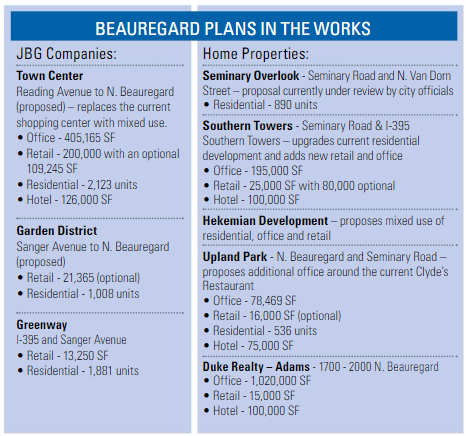Renewed signs of life among Northern Virginia’s commercial real estate markets cast doubt on the predictions by economic forecasters writing obituaries for America’s suburbs.
Nationally, suburban markets have accounted for 80 percent of total office absorption since 2007, reported Bob Bach, director of research for commercial real estate firm Newmark Grubb Knight Frank at the May NAR Realtor® Party Convention and Trade Show in Washington, D.C.
Northern Virginia development hotspots such as Clarendon, Reston, Tysons and Potomac Yards have led the suburban resurgence.
This past spring, the City of Alexandria adopted plans and revised zoning to begin implementation of the Beauregard Small Area Plan (BSAP), in hopes of adding the City's long stagnant West End.
In the works for the past three years, the BSAP will transform 220 acres along Beauregard Street and I-395, from Seminary Road, just west of the Northern Virginia Community College campus, to the City’s western boundary with Fairfax County. Among the catalysts for the city’s planning effort was the U.S. Department of Defense Base Realignment and Closure (BRAC) implementation, which brought 6,400 new employees to the Mark Center on Seminary Road at I-395 in 2012.
While the plan envisions more urban residential concentrations, the good news for commercial Realtors®, according to Alexandria’s Deputy City Manager Mark Jinks, will be the increased retail in the mix. He predicts that further commercial development adjacent to the plan area along Seminary Road, King Street and Little River Turnpike will be necessary to support the rejuvenated neighborhood’s increased population.
The entire area currently contains some 6 million square feet of development. Current zoning allows up to 10 million square feet, but the “upzoning” approved by the City Council to implement the BSAP increases that to 12 million square feet, including a minimum of 250,000 square feet of new retail space.
The area’s current development occurred primarily in the 1950s. Since that time, the local population has increased from roughly 62,000 residents to more than 140,000. Its existing mix of suburban apartment housing, low-rise offices and a shopping center will be replaced with more urban-style neighborhoods featuring mixed-use developments of offices, hotels, retail areas and a variety of multifamily homes surrounded by open “green space.”
Transportation improvements include a new traffic oval “ellipse” for the Seminary and Beauregard intersection, sidewalks, multi-use trails, improved bicycle connectivity – including on street bicycle lanes – and a more urban-friendly street grid. The smaller block sizes and improved pedestrian access will be in line with the “work, shop and play where you live” mantra taking shape throughout the region.
Also included are plans for rapid transit bus service along the Beauregard corridor from Seminary Road connecting to the nearby Landmark area and the Van Dorn Metro station.
The city has been meeting with planners from Arlington and Fairfax counties, as well as the Defense Department, to integrate transportation plans with the neighboring areas, Jinks explained. Existing bus connections from the Mark Center to the Pentagon could be expanded, as well as connections to Arlington County’s planned trolley line on Columbia Pike, the Shirlington area and other nearby centers.
The plan attempts to retain much of the bucolic character of the area, including preserving and enhancing the existing botanical garden and nature park with more connected green space, including new “tot lots,” dog parks and a community garden.
To facilitate the new development, existing infrastructure including water and sewer lines will be updated and replaced, and a new fire station will be added at the intersection of N. Beauregard and Sanger Avenue.
During the next 20 to 30 years, developers will demolish nearly half of the existing apartments. They will be replaced with 5,000 new housing units, including apartments, townhouses and condos, of which 800 will be dedicated low income housing. “It’s the city’s largest single commitment to affordable housing in its history,” Jinks said.
The BPAS does not require the piecemeal acquisition of property, Jinks explained. The land involved in the redevelopment is currently owned by five developers, with the largest one, the JBG Companies, holding 130 acres. The remainder is split between Duke Realty, Southern Towers, Home Properties and Hekemian Development. The developers will contribute an estimated $160.2 million in rights of way, construction of the fire station and other “in kind” contributions, amounting to roughly $13 per square foot of developable space.
“This is a complete pay as you go plan,” Jinks said. The City expects to collect and set aside $52.4 million in additional property tax revenues from this development.
Now that the City has adopted the plan, construction could soon begin. Home Properties, which plans to develop 890 residential units in Seminary Overlook along Seminary Road and Van Dorn Street, has already presented plans to the City to begin construction.
Jinks suggested that Realtors® keep abreast of the coming changes by participating in public meetings as the plan is implemented.
 Frank Dillow is chair of NVAR's Realtor® Commercial Council and is a vice president in Long & Foster's Commercial division. He can be reached at francis.dillow@longandfoster.com.
Frank Dillow is chair of NVAR's Realtor® Commercial Council and is a vice president in Long & Foster's Commercial division. He can be reached at francis.dillow@longandfoster.com.